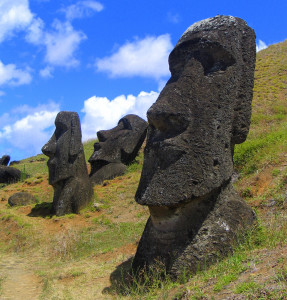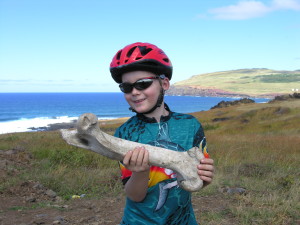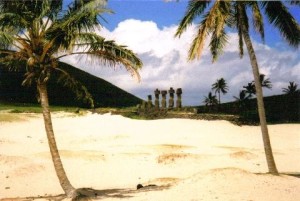(This story of Kirsten’s is in the humorous travel book Leave the Lipstick, Take the Iguana published by Travelers’ Tales, USA)
Easter Island and the Chilean with the Brazilian
When a family adventure unexpectedly turns X-rated
BY KIRSTEN KOZA
My obsession with Easter Island’s mysterious monolithic stone statues started when I was around five-years-old after I’d seen the film Chariots of the Gods. In the movie, aliens had helped the natives of Easter Island erect stone monoliths called moai. Of course I now know that aliens had nothing to do with the moai—I mean, come on, if extraterrestrials could build a space ship to fly across galaxies, surely they’d do something else with their spare time besides helping scantily clad Polynesians carve rudimentary cement-truck-sized statues on one of the most remote inhabited islands in the world, 3686 kilometers off the coast of Chile.
 Finally, forty years later, I was hiking up Rano Raraku volcano, the birth place of the moai, with my seven-year-old son, Rigel. I pulled my collar up to protect my neck from the ruthless sun and pulled my hat down over my face to hide my already blistered lips. No shade in sight, the Rapa Nui natives had eviscerated the island of trees to transport their statues across the volcanic terrain. I recognized individual moai from Thor Heyerdahl’s book. I was about as close to Nirvana as I could get. Rigel and I continued up slowly.
Finally, forty years later, I was hiking up Rano Raraku volcano, the birth place of the moai, with my seven-year-old son, Rigel. I pulled my collar up to protect my neck from the ruthless sun and pulled my hat down over my face to hide my already blistered lips. No shade in sight, the Rapa Nui natives had eviscerated the island of trees to transport their statues across the volcanic terrain. I recognized individual moai from Thor Heyerdahl’s book. I was about as close to Nirvana as I could get. Rigel and I continued up slowly.
“Can we go to the beach now? It’s hot,” Rigel gasped.
I looked at his little scarlet face and then the giant moai lying stacked upon one another, still in the midst of being carved out of the volcano’s walls but frozen in process by an outbreak of tribal war, which was followed by despair and cannibalism, and then an invasion of slave traders in the 1800s. “Yeah, O.K.,” I agreed. We had three weeks here, so no rush. I’d hang with Rigel. I looked around for my husband, Malcolm, and my friend Karen who’d gone ahead.
Rigel and I descended the dust-slick rock path. We ended up stuck behind two Chilean women in high-heeled beach sandals (stiletto flip flops). Their skirts were flapping in the strong breeze and their tight-jeaned man, equally encumbered by his attire was failing dismally at helping either lady down the slope.
“Excuse me, excuse us,” I said as Rigel and I skidded past the traffic jam of frills and girly-girls clutching their cologne soaked he-man.
As I helped Rigel climb down a steep rock below one of the Chilean princesses, her dress blew up like Marilyn Monroe’s—except this wasn’t family rated. I saw Rigel’s face blanch and his pupils dilate.
Rigel leapt towards me, grabbed my hand, and pulled me down the steep incline at break-neck speed. “Why did that woman’s vagina look like that?”
Oh, God.
“Her vagina hair was just a thin black stripe,” Rigel said in shock.

I hoped this was not going to be his first journal entry in his Easter Island Diary that he was bringing back to his grade one teacher and class. As it was, the teacher disapproved of me taking Rigel out of school for a three week trip. She thought his life might be adversely affected by missing that much cut and paste and carpet time.
“Did her hair on her vagina grow into that shape?”
“No, she’s had it waxed.” Shit.
“Like a car?” Rigel asked. “Is that why her vagina was so shiny?”
“No, that was tanning oil or something.”
“Why would she want a wax and tan on her vagina?”
“Rigel, you see that moai over there. His name is El Gigante and he weighs over four hundred thousand pounds.” I pointed to the resting giant. “He was someone’s real great great-great granddad, as all the moai were shaped and carved for real Rapa Nui people.”
“Where is she from?” Rigel inquired.
“Huh?” I looked at El Gigante. It would have taken an entire tribe or clan a whole year to carve this.
Rigel tugged my arm. “What country is that woman from?”
“She’s Chilean,” I said.
“Do people from different countries have pubic hair that grows in different shapes?”
Oh, great. “No, she’s had most of her pubic hair removed.” I stopped myself from going any further. We were at one of the world’s greatest archaeological wonders and I wasn’t about to give my son a lesson on bikini waxing styles.
“Can you pick the shape you want your pubic hair to be? Do you ever do that to yours?”
“No!”
“Hers was a zebra.”
“It was a Brazilian,” I said.
“Why would a Chilean want a Brazilian on her vagina?” Rigel asked.

Later, my friend Karen and I stood in the soft white sand below the moai, at Anakena beach, while my husband took over cooking lunch in a large Rapa Nui woman’s beach kiosk. Anakena was where the Rapa Nui canoes had first arrived, after their treacherous 3900-kilometer paddle across the South Pacific, from the Marquesas Islands. Rigel ran around impatiently as we took pictures.
“I can’t believe we’re here,” said Karen. “It’s incredible. I never fathomed the size of the monoliths or how hard it must have been to transport them around the island.”
“Karen,” I whispered. “It’s a good thing you educated me on all the varieties of pubic epilation the other day. It came in handy at Rano Raraku.”
“Why?” Karen asked, moving her sunglasses down her nose to look at me.
“A couple of Chilean women were going commando and Rigel had frontal view of beaver.”
Karen laughed. “So which style was it?”
“It was a Brazilian beaver.”
“Full? As in the naked Sphinx?” Karen inquired.
“No, there was a landing strip.”
Karen laughed even louder. Hey, Rigel,” Karen called. “Did you know that one of the statues’ hats weighs as much as two elephants?”
Rigel ran over. He was excited. “Mom, Karen, guess what?”
“What?”
“That Chilean woman is here!”










